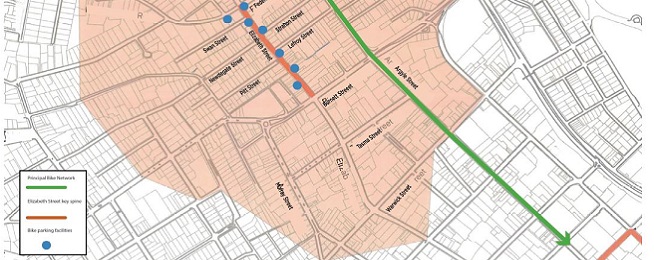The City of Hobart has released consultant reports on the future of the North Hobart shopping strip, but they are light on details when it comes to improving bicycle access.
The document Part B – Access and Parking contains the bulk of discussion and recommendations about bicycle access and parking.
While it acknowledges community aspiration and the problems with current conditions for bike riding, it stops short of recommending specific infrastructure or treatments for particular routes, other than to introduce a back streets connection between North and West Hobart.
It identifies that Elizabeth Street is preferred by most riders, despite Argyle Street being the City of Hobart’s official route through this area. This is because traffic is generally slower in Elizabeth Street than in Argyle Street, it’s generally a more interesting and direct route, and the bi-directional rather than one-way traffic flow.
The consultants recognise the myriad problems Hobart faces by continuing with a one-way network, and that includes providing an effective bicycle network.
The consultants’ main recommendations to improve cycling are:
- review the Principal Bicycle Network in line with working towards development of a complete network
- develop ‘shimmy’ route linking North Hobart and West Hobart
- improve cycling on Elizabeth Street as part of preferred future street reconfiguration
- introduce new bike parking facilities
- improve cycling facilities and infrastructure on Argyle Street.
The report does not recommend any change to the ability to park on both sides of Elizabeth Street, leaving no new space to create dedicated cycling facilities.
Latent demand for riding
Consultation for the project found that around 5% of people regularly ride to the strip despite many people feeling unsafe, especially the “tendency for bikes to be squeezed into the door zone, with cars closely overtaking”.
It also found there is latent demand for riding of about 15%. The consultants said if there was dedicated cycling infrastructure it would lead to more people riding to and from the strip as the quality of cycling infrastructure is “a major determinant of levels of cycling”.
“As the greatest barrier to cycling is safety (both real and perceived), the most important parameter in designing for inclusive cycling is protection from moving traffic on streets with moderate or high traffic volumes and/or speeds.”
Inadequate cycling facilities

The report lists the problems with current conditions for bike riding, saying there are “widespread examples of cycling facilities that are inappropriate for street conditions and are unlikely to lead to significant future uptake of cycling”.
While it stops short of recommending infrastructure treatments, it does point out that the current high volume of traffic along Elizabeth Street means protected, separated bicycle lanes would be the only type of infrastructure that should be provided.
It also says that if traffic was encouraged to move off Elizabeth Street and volume could be halved on current numbers, then cycling could be provided for in mixed traffic or cycle lanes.
The report recommends connecting the existing incomplete network, including protected lanes on key routes and intersections, and introducing “shimmy routes”, which are sign-posted routes through low-stress, low-traffic back streets. These have worked in Melbourne where streets have been significantly traffic-calmed, have low numbers of vehicles and are direct enough that riders aren’t unduly delayed.
The report recommends the first shimmy could use Newdegate Street to connect North Hobart and West Hobart, but doesn’t present the traffic volumes and condition of such a route and what work would be needed to bring it to a comfortable standard.
Next steps
Other reports have specifically addressed alternative futures for Elizabeth Street, notably the Tasmanian Government’s 2018 Hobart Transport Vision, the RACT’s 2019 Greater Hobart Mobility Vision and Tasmanian Bicycle Council’s Hobart CBD Cycleways.
The government and RACT envision a street just for riding, walking and public transport, not dissimilar to the way Swanston Street operates in Melbourne but with buses instead of trams. While the Bicycle Council wants to see an uphill separated cycleway, the removal of car parking on the downhill side and a drop in speed limits to 30 km/h.
The City of Hobart and Tasmanian Government are working together on two plans – Hobart Network Plan and the Central Precincts Plan – that together are supposed to map a future for the uses of our city streets.
The consultants’ recommendations to review the Principal Bicycle Network should be captured by the two planning processes underway.
The City of Hobart has announced more public consultation will follow the release of these reports, but not what that will be or when.


